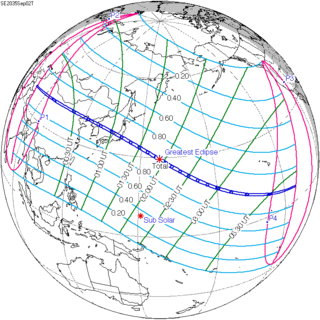Solar eclipse of September 2, 2035
| Solar eclipse of September 2, 2035 | |
|---|---|
| Type of eclipse | |
| Nature | Total |
| Gamma | 0.3727 |
| Magnitude | 1.032 |
| Maximum eclipse | |
| Duration | 174 s (2 min 54 s) |
| Coordinates | 29°06′N 158°00′E / 29.1°N 158°E |
| Max. width of band | 116 km (72 mi) |
| Times (UTC) | |
| Greatest eclipse | 1:56:46 |
| References | |
| Saros | 145 (23 of 77) |
| Catalog # (SE5000) | 9586 |
A total solar eclipse will occur on Sunday, September 2, 2035. A solar eclipse occurs when the Moon passes between Earth and the Sun, thereby totally or partly obscuring the image of the Sun for a viewer on Earth. A total solar eclipse occurs when the Moon's apparent diameter is larger than the Sun's, blocking all direct sunlight, turning day into darkness. Totality occurs in a narrow path across Earth's surface, with the partial solar eclipse visible over a surrounding region thousands of kilometres wide.
Visibility

The path of totality will cross two Asian capital cities, Beijing, China and Pyongyang, North Korea, and will pass north of a third, Tokyo, Japan.[1]
Related eclipses
Solar eclipses of 2033–2036
This eclipse is a member of a semester series. An eclipse in a semester series of solar eclipses repeats approximately every 177 days and 4 hours (a semester) at alternating nodes of the Moon's orbit.[2]
The partial solar eclipse on July 23, 2036 occurs in the next lunar year eclipse set.
| Solar eclipse series sets from 2033 to 2036 | ||||||
|---|---|---|---|---|---|---|
| Descending node | Ascending node | |||||
| Saros | Map | Gamma | Saros | Map | Gamma | |
| 120 | March 30, 2033 Total |
0.9778 | 125 | September 23, 2033 Partial |
−1.1583 | |
| 130 | March 20, 2034 Total |
0.2894 | 135 | September 12, 2034 Annular |
−0.3936 | |
| 140 | March 9, 2035 Annular |
−0.4368 | 145 | September 2, 2035 Total |
0.3727 | |
| 150 | February 27, 2036 Partial |
−1.1942 | 155 | August 21, 2036 Partial |
1.0825 | |
Saros 145
This eclipse is a part of Saros series 145, repeating every 18 years, 11 days, and containing 77 events. The series started with a partial solar eclipse on January 4, 1639. It contains an annular eclipse on June 6, 1891; a hybrid eclipse on June 17, 1909; and total eclipses from June 29, 1927 through September 9, 2648. The series ends at member 77 as a partial eclipse on April 17, 3009. Its eclipses are tabulated in three columns; every third eclipse in the same column is one exeligmos apart, so they all cast shadows over approximately the same parts of the Earth.
The longest duration of annularity was produced by member 15 at 6 seconds (by default) on June 6, 1891, and the longest duration of totality will be produced by member 50 at 7 minutes, 12 seconds on June 25, 2522. All eclipses in this series occur at the Moon’s ascending node of orbit.[3]
| Series members 10–32 occur between 1801 and 2200: | ||
|---|---|---|
| 10 | 11 | 12 |
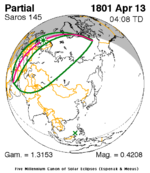 April 13, 1801 |
 April 24, 1819 |
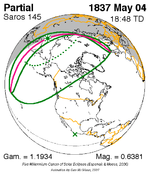 May 4, 1837 |
| 13 | 14 | 15 |
 May 16, 1855 |
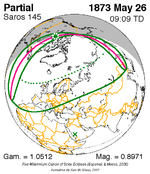 May 26, 1873 |
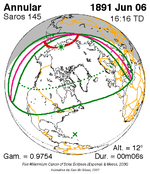 June 6, 1891 |
| 16 | 17 | 18 |
 June 17, 1909 |
 June 29, 1927 |
 July 9, 1945 |
| 19 | 20 | 21 |
 July 20, 1963 |
 July 31, 1981 |
 August 11, 1999 |
| 22 | 23 | 24 |
 August 21, 2017 |
 September 2, 2035 |
 September 12, 2053 |
| 25 | 26 | 27 |
 September 23, 2071 |
 October 4, 2089 |
 October 16, 2107 |
| 28 | 29 | 30 |
 October 26, 2125 |
 November 7, 2143 |
 November 17, 2161 |
| 31 | 32 | |
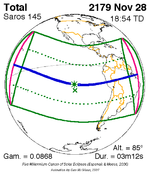 November 28, 2179 |
 December 9, 2197 | |
Inex series
This eclipse is a part of the long period inex cycle, repeating at alternating nodes, every 358 synodic months (≈ 10,571.95 days, or 29 years minus 20 days). Their appearance and longitude are irregular due to a lack of synchronization with the anomalistic month (period of perigee). However, groupings of 3 inex cycles (≈ 87 years minus 2 months) comes close (≈ 1,151.02 anomalistic months), so eclipses are similar in these groupings.
| Inex series members between 1901 and 2100: | ||
|---|---|---|
 November 22, 1919 (Saros 141) |
 November 1, 1948 (Saros 142) |
 October 12, 1977 (Saros 143) |
 September 22, 2006 (Saros 144) |
 September 2, 2035 (Saros 145) |
 August 12, 2064 (Saros 146) |
 July 23, 2093 (Saros 147) |
||
Tritos series
This eclipse is a part of a tritos cycle, repeating at alternating nodes every 135 synodic months (≈ 3986.63 days, or 11 years minus 1 month). Their appearance and longitude are irregular due to a lack of synchronization with the anomalistic month (period of perigee), but groupings of 3 tritos cycles (≈ 33 years minus 3 months) come close (≈ 434.044 anomalistic months), so eclipses are similar in these groupings.
| Series members between 1901 and 2100 | |||
|---|---|---|---|
 September 9, 1904 (Saros 133) |
 August 10, 1915 (Saros 134) |
 July 9, 1926 (Saros 135) | |
 June 8, 1937 (Saros 136) |
 May 9, 1948 (Saros 137) |
 April 8, 1959 (Saros 138) | |
 March 7, 1970 (Saros 139) |
 February 4, 1981 (Saros 140) |
 January 4, 1992 (Saros 141) | |
 December 4, 2002 (Saros 142) |
 November 3, 2013 (Saros 143) |
 October 2, 2024 (Saros 144) | |
 September 2, 2035 (Saros 145) |
 August 2, 2046 (Saros 146) |
 July 1, 2057 (Saros 147) | |
 May 31, 2068 (Saros 148) |
 May 1, 2079 (Saros 149) |
 March 31, 2090 (Saros 150) | |
Metonic series
The metonic series repeats eclipses every 19 years (6939.69 days), lasting about 5 cycles. Eclipses occur in nearly the same calendar date. In addition, the octon subseries repeats 1/5 of that or every 3.8 years (1387.94 days). All eclipses in this table occur at the Moon's ascending node.
| 21 eclipse events between June 21, 1982 and June 21, 2058 | ||||
|---|---|---|---|---|
| June 21 | April 8–9 | January 26 | November 13–14 | September 1–2 |
| 117 | 119 | 121 | 123 | 125 |
 June 21, 1982 |
 April 9, 1986 |
 January 26, 1990 |
 November 13, 1993 |
 September 2, 1997 |
| 127 | 129 | 131 | 133 | 135 |
 June 21, 2001 |
 April 8, 2005 |
 January 26, 2009 |
 November 13, 2012 |
 September 1, 2016 |
| 137 | 139 | 141 | 143 | 145 |
 June 21, 2020 |
 April 8, 2024 |
 January 26, 2028 |
 November 14, 2031 |
 September 2, 2035 |
| 147 | 149 | 151 | 153 | 155 |
 June 21, 2039 |
 April 9, 2043 |
 January 26, 2047 |
 November 14, 2050 |
 September 2, 2054 |
| 157 | ||||
 June 21, 2058 | ||||
References
- ^ Kennedy, Kelsey (August 21, 2017). "If You Missed This Year's Eclipse, Chase Another". Atlas Obscura. Retrieved December 12, 2017.
- ^ van Gent, R.H. "Solar- and Lunar-Eclipse Predictions from Antiquity to the Present". A Catalogue of Eclipse Cycles. Utrecht University. Retrieved 6 October 2018.
- ^ "NASA - Catalog of Solar Eclipses of Saros 145". eclipse.gsfc.nasa.gov.

